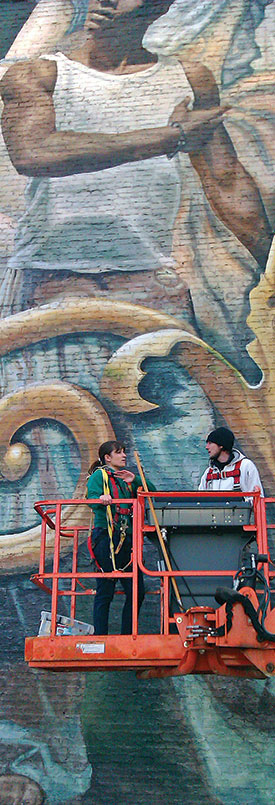

What led you into this work to save outdoor murals?
When I initially learned of UD's Preservation Studies Program, I wanted to investigate varnishes using analytical chemistry. In one of my first meetings with the program director, Prof. Joyce Hill Stoner, we talked about how the conservation field needed research in the modern art field, particularly the preservation of public murals.
Outdoor public murals are an underrepresented group in conservation research. Since I started at UD in 2008, I've learned so much about the subject matter, the artists who work so hard to create and share their visions with the public, the caretakers who are dedicated to saving these beautiful murals, and the people who simply enjoy murals and want them to last as long as possible. The people I've met during my research are so animated and driven to save public murals that I couldn't help but be drawn into the outdoor mural community.
When I look at murals as I'm wandering around a city or viewing them on the Internet, I want to learn more about the maker and the story behind the imagery. Was the mural intended to represent a community, to be considered a sign of progress (or protest), or simply created to beautify and energize a public space?
When I see a faded mural, one that has had graffiti or perhaps patches of lost paint, I want to know if there had been warning signs that might have allowed mural caretakers to prevent further degradation. If there are common markers, how can they be identified so that the wider mural community can be aware of when actions need to be taken? With my research at UD, I hope to identify some of these markers and then offer preservation solutions.
What project are you currently working on?
I'm working on the aging of several protective coatings for outdoor murals. Coatings need to respond well to changes in UV exposure, temperature and humidity over time. I'm looking at the usefulness over time of UV-protective coatings, where the coating could act like a sunscreen, protecting sensitive pigments in the mural paint from UV rays that could lead to fading, or other damage to the paint, like cracking and flaking.
The aging of the coatings will help me separate the useful coatings from those that won't provide beneficial coverage to outdoor murals. One of my recent projects involved consulting on the restoration of Meg Saligman's Common Threads in Philadelphia (photo at left). The artist was able to successfully use a UV-protective coating to resaturate the bold colors that had been muted over time, and the coating should help the colors to remain as vibrant in the future.
What do you hope to do once you've completed your Ph.D.?
I'm looking forward to a post-doc where I'll be teaching chemistry and the science of art, and I'll also continue researching ways to better conserve outdoor murals using science.
In the future, I hope to work in a museum science research department, where new research questions about art materials and their conservation concerns can be investigated using a combination of art history, science and public engagement.